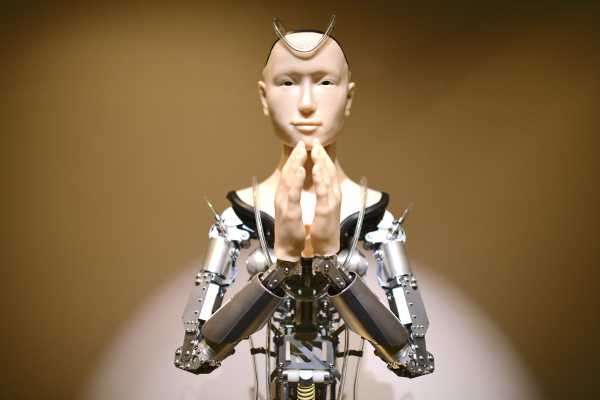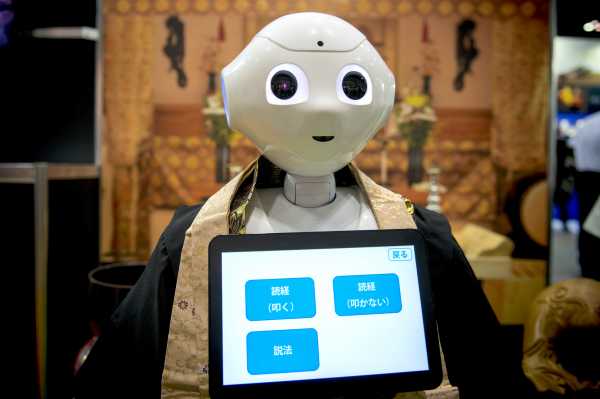
Robot priests can bless you, advise you, and even perform your funeral
AI religion is upon us. Welcome to the future.
By
Sigal Samuel
Sep 9, 2019, 11:10am EDT
Share this story
-
Share this on Facebook
-
Share this on Twitter
-
Share
All sharing options
Share
All sharing options for:
Robot priests can bless you, advise you, and even perform your funeral
-
Reddit
-
Pocket
-
Flipboard
-
Email
This story is part of a group of stories called

Finding the best ways to do good. Made possible by The Rockefeller Foundation.
A new priest named Mindar is holding forth at Kodaiji, a 400-year-old Buddhist temple in Kyoto, Japan. Like other clergy members, this priest can deliver sermons and move around to interface with worshippers. But Mindar comes with some … unusual traits. A body made of aluminum and silicone, for starters.
Mindar is a robot.
Designed to look like Kannon, the Buddhist deity of mercy, the $1 million machine is an attempt to reignite people’s passion for their faith in a country where religious affiliation is on the decline.
For now, Mindar is not AI-powered. It just recites the same preprogrammed sermon about the Heart Sutra over and over. But the robot’s creators say they plan to give it machine-learning capabilities that’ll enable it to tailor feedback to worshippers’ specific spiritual and ethical problems.
“This robot will never die; it will just keep updating itself and evolving,” said Tensho Goto, the temple’s chief steward. “With AI, we hope it will grow in wisdom to help people overcome even the most difficult troubles. It’s changing Buddhism.”
Robots are changing other religions, too. In 2017, Indians rolled out a robot that performs the Hindu aarti ritual, which involves moving a light round and round in front of a deity. That same year, in honor of the Protestant Reformation’s 500th anniversary, Germany’s Protestant Church created a robot called BlessU-2. It gave preprogrammed blessings to over 10,000 people.
Then there’s SanTO — short for Sanctified Theomorphic Operator — a 17-inch-tall robot reminiscent of figurines of Catholic saints. If you tell it you’re worried, it’ll respond by saying something like, “From the Gospel according to Matthew, do not worry about tomorrow, for tomorrow will worry about itself. Each day has enough trouble of its own.”
Roboticist Gabriele Trovato designed SanTO to offer spiritual succor to elderly people whose mobility and social contact may be limited. Next, he wants to develop devices for Muslims, though it remains to be seen what form those might take.
As more religious communities begin to incorporate robotics — in some cases, AI-powered and in others, not — it stands to change how people experience faith. It may also alter how we engage in ethical reasoning and decision-making, which is a big part of religion.
For the devout, there’s plenty of positive potential here: Robots can get disinterested people curious about religion or allow for a ritual to be performed when a human priest is inaccessible. But robots also pose risks for religion — for example, by making it feel too mechanized or homogenized or by challenging core tenets of theology. On the whole, will the emergence of AI religion make us better or worse off? The answer depends on how we design and deploy it — and on whom you ask.
Some cultures are more open to religious robots than others
New technologies often make us uncomfortable. Which ones we ultimately accept — and which ones we reject — is determined by an array of factors, ranging from our degree of exposure to the emerging technology to our moral presuppositions.
Japanese worshippers who visit Mindar are reportedly not too bothered by questions about the risks of siliconizing spirituality. That makes sense given that robots are already so commonplace in the country, including in the religious domain.
For years now, people who can’t afford to pay a human priest to perform a funeral have had the option to pay a robot named Pepper to do it at a much cheaper rate. And in China, at Beijing’s Longquan Monastery, an android monk named Xian’er recites Buddhist mantras and offers guidance on matters of faith.
What’s more, Buddhism’s non-dualistic metaphysical notion that everything has inherent “Buddha nature” — that all beings have the potential to become enlightened — may predispose its adherents to be receptive to spiritual guidance that comes from technology.
At the temple in Kyoto, Goto put it like this: “Buddhism isn’t a belief in a God; it’s pursuing Buddha’s path. It doesn’t matter whether it’s represented by a machine, a piece of scrap metal, or a tree.”
“Mindar’s metal skeleton is exposed, and I think that’s an interesting choice — its creator, Hiroshi Ishiguro, is not trying to make something that looks totally human,” said Natasha Heller, an associate professor of Chinese religions at the University of Virginia. She told me the deity Kannon, upon whom Mindar is based, is an ideal candidate for cyborgization because the Lotus Sutra explicitly says Kannon can manifest in different forms — whatever forms will best resonate with the humans of a given time and place.
Westerners seem more disturbed by Mindar, likening it to Frankenstein’s monster. In Western economies, we don’t yet have robots enmeshed in many aspects of our lives. What we do have is a pervasive cultural narrative, reinforced by Hollywood blockbusters, about our impending enslavement at the hands of “robot overlords.”
Plus, Abrahamic religions like Islam or Judaism tend to be more metaphysically dualistic — there’s the sacred and then there’s the profane. And they have more misgivings than Buddhism about visually depicting divinity, so they may take issue with Mindar-style iconography.
They also have different ideas about what makes a religious practice effective. For example, Judaism places a strong emphasis on intentionality, something machines don’t possess. When a worshipper prays, what matters is not just that their mouth forms the right words — it’s also very important that they have the right intention.
Meanwhile, some Buddhists use prayer wheels containing scrolls printed with sacred words and believe that spinning the wheel has its own spiritual efficacy, even if nobody recites the words aloud. In hospice settings, elderly Buddhists who don’t have people on hand to recite prayers on their behalf will use devices known as nianfo ji — small machines about the size of an iPhone, which recite the name of the Buddha endlessly.
Despite such theological differences, it’s ironic that many Westerners have a knee-jerk negative reaction to a robot like Mindar. The dream of creating artificial life goes all the way back to ancient Greece, where the ancients actually invented real animated machines as the Stanford classicist Adrienne Mayor has documented in her book Gods and Robots. And there is a long tradition of religious robots in the West.
In the Middle Ages, Christians designed automata to perform the mysteries of Easter and Christmas. One proto-roboticist in the 16th century designed a mechanical monk that is, amazingly, performing ritual gestures to this day. With his right arm, he strikes his chest in a mea culpa; with his left, he raises a rosary to his lips.
In other words, the real novelty is not the use of robots in the religious domain but the use of AI.

How AI may change our theology and ethics
Even as our theology shapes the AI we create and embrace, AI will also shape our theology. It’s a two-way street.
Some people believe AI will force a truly momentous change in theology, because if humans create intelligent machines with free will, we’ll eventually have to ask whether they have something functionally similar to a soul.
“There will be a point in the future when these free-willed beings that we’ve made will say to us, ‘I believe in God. What do I do?’ At that point, we should have a response,” said Kevin Kelly, a Christian co-founder of Wired magazine who argues we need to develop “a catechism for robots.”
Other people believe that, rather than seeking to join a human religion, AI itself will become an object of worship. Anthony Levandowski, the Silicon Valley engineer who triggered a major Uber/Waymo lawsuit, has set up the first church of artificial intelligence, called Way of the Future. Levandowski’s new religion is dedicated to “the realization, acceptance, and worship of a Godhead based on artificial intelligence (AI) developed through computer hardware and software.”
Meanwhile, Ilia Delio, a Franciscan sister who holds two PhDs and a chair in theology at Villanova University, told me AI may also force a traditional religion like Catholicism to reimagine its understanding of human priests as divinely called and consecrated — a status that grants them special authority.
“The Catholic notion would say the priest is ontologically changed upon ordination. Is that really true?” she asked. Maybe priestliness is not an esoteric essence but a programmable trait that even a “fallen” creation like a robot can embody. “We have these fixed philosophical ideas and AI challenges those ideas — it challenges Catholicism to move toward a post-human priesthood.” (For now, she joked, a robot would probably do better as a Protestant.)
Then there are questions about how robotics will change our religious experiences. Traditionally, those experiences are valuable in part because they leave room for the spontaneous and surprising, the emotional and even the mystical. That could be lost if we mechanize them.
To visualize an automated ritual, take a look at this video of a robotic arm performing a Hindu aarti ceremony:
Another risk has to do with how an AI priest would handle ethical queries and decision-making. Robots whose algorithms learn from previous data may nudge us toward decisions based on what people have done in the past, incrementally homogenizing answers to our queries and narrowing the scope of our spiritual imagination.
That risk also exists with human clergy, Heller pointed out: “The clergy is bounded too — there’s already a built-in nudging or limiting factor, even without AI.”
But AI systems can be particularly problematic in that they often function as black boxes. We typically don’t know what sorts of biases are coded into them or what sorts of human nuance and context they’re failing to understand.
Let’s say you tell a robot you’re feeling depressed because you’re unemployed and broke, and the only job that’s available to you seems morally odious. Maybe the robot responds by reciting a verse from Proverbs 14: “In all toil there is profit, but mere talk tends only to poverty.” Even if it doesn’t presume to interpret the verse for you, in choosing that verse it’s already doing hidden interpretational work. It’s analyzing your situation and algorithmically determining a recommendation — in this case, one that may prompt you to take the job.
But perhaps it would’ve worked out better for you if the robot had recited a verse from Proverbs 16: “Commit your work to the Lord, and your plans will be established.” Maybe that verse would prompt you to pass on the morally dubious job, and, being a sensitive soul, you’ll later be happy you did. Or maybe your depression is severe enough that the job issue is somewhat beside the point and the crucial thing is for you to seek out mental health treatment.
A human priest who knows your broader context as a whole person may gather this and give you the right recommendation. An android priest might miss the nuances and just respond to the localized problem as you’ve expressed it.
The fact is human clergy members do so much more than provide answers. They serve as the anchor for a community, bringing people together. They offer pastoral care. And they provide human contact, which is in danger of becoming a luxury good as we create robots to more cheaply do the work of people.
On the other hand, Delio said, robots can excel in a social role in some ways that human priests might not. “Take the Catholic Church. It’s very male, very patriarchal, and we have this whole sexual abuse crisis. So would I want a robot priest? Maybe!” she said. “A robot can be gender-neutral. It might be able to transcend some of those divides and be able to enhance community in a way that’s more liberating.”
Ultimately, in religion as in other domains, robots and humans are perhaps best understood not as competitors but as collaborators. Each offers something the other lacks.
As Delio put it, “We tend to think in an either/or framework: It’s either us or the robots. But this is about partnership, not replacement. It can be a symbiotic relationship — if we approach it that way.”
Reporting for this article was supported by Public Theologies of Technology and Presence, a journalism and research initiative based at the Institute of Buddhist Studies and funded by the Henry Luce Foundation.
Sign up for the Future Perfect newsletter. Twice a week, you’ll get a roundup of ideas and solutions for tackling our biggest challenges: improving public health, decreasing human and animal suffering, easing catastrophic risks, and — to put it simply — getting better at doing good.
Sourse: vox.com




